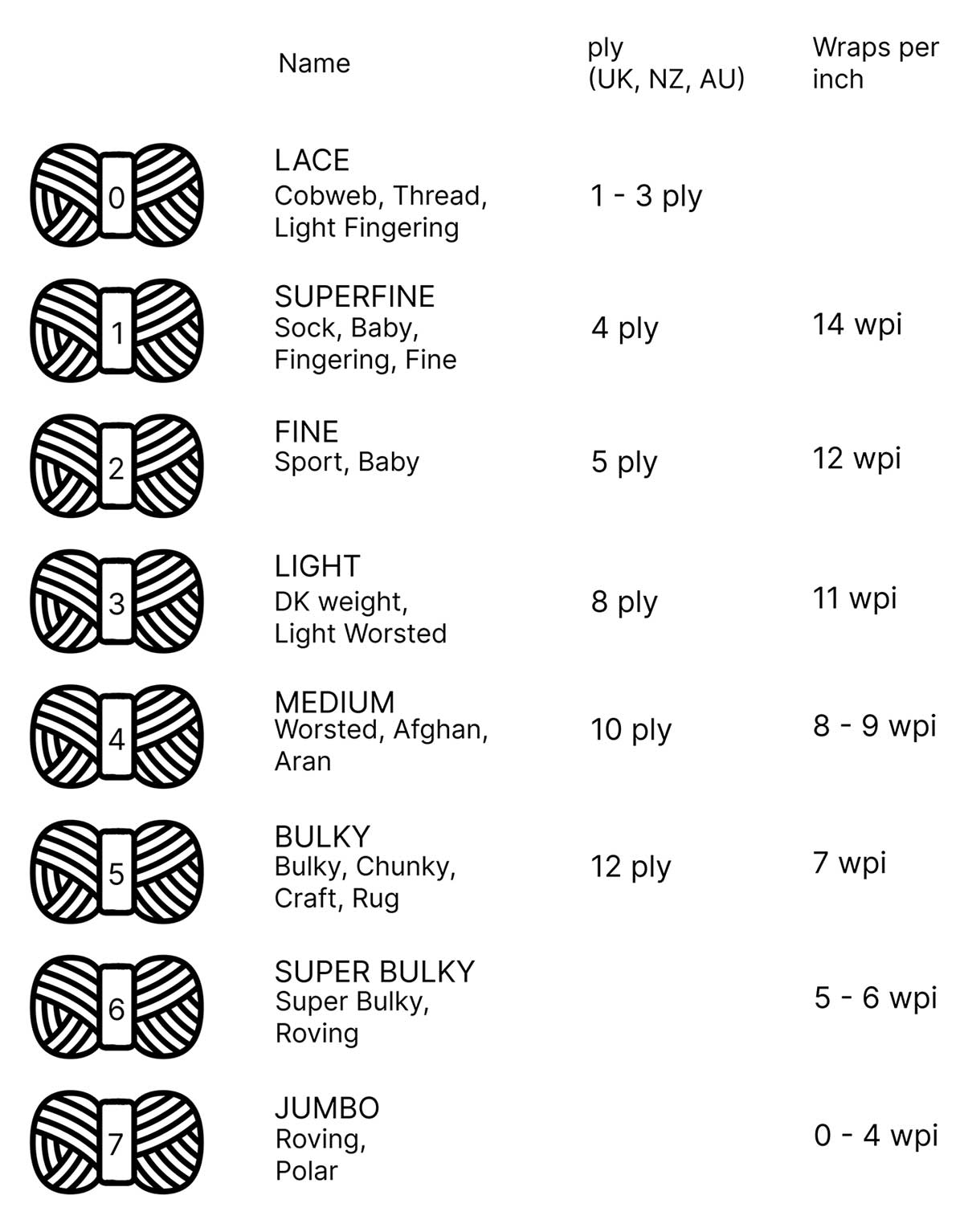Navigating the realm of yarn is an art, and at the heart of this craft lies the essential guide: the yarn weight chart. In this blog post, we’ll unravel the significance of this chart, delving into its categories and how it shapes your crafting journey.
Various regions and different yarn manufacturers also use alternative terms. For instance, North Americans commonly use “worsted weight,” whereas “aran weight” is more prevalent in the UK and Europe.
Yarn Weight Chart
Lace weight (0)
Alternative term: Cobweb, Thread, Light Fingering
The thinnest yarn, used for lightweight shawls, delicate doilies, or intricate lace garments that showcase the beauty of individual stitches.
Super fine weight (1)
Alternative terms: Sock, Baby, Fingering, Fine
Despite its thinness, super fine weight yarn is surprisingly versatile. Commonly used for lightweight garments like socks, shawls, and delicate accessories.
Fine weight (2)
Alternative terms: Sport, Baby
Often used for baby clothes, socks, lightweight garments, shawls, and accessories.
Light weight (3)
Alternative terms: DK weight (DK – double knitting), Light Worsted
Used for sweaters, cardigans, tops, baby clothes, gloves, socks… It’s also a good choice for crafting toys and amigurumi projects.
Medium weight (4)
Alternative terms: Worsted, Afghan, Aran
Also known as worsted weight. Perfect for crafting sweaters, cardigans, hats, scarves, and other wearable items. I often recommend worsted weight yarn for beginners due to its ease of use and visibility of stitches. Perfect for blankets or afghans for all seasons, stuffed animals and toys, and home decor items such as pillows, throws, and cushions.
Bulky weight (5)
Alternative terms: Bulky, Chunky, Craft, Rug
Ideal for projects that you want to complete quickly due to its substantial thickness. Perfect for crafting warm winter wear such as chunky scarves, hats, and sweaters. Well-suited for making chunky pillows, rugs, and other home decor items.
Super bulky weight (6)
Alternative terms: Super Bulky, Roving
Perfect for crafting chunky scarves, snoods, and oversized hats and sweaters. It’s also great for making chunky pillows, floor poufs, and other decorative items. For beginners that are impatient and want to see quick and satisfying results I recommend bulky weight yarn.
Jumbo weight (7)
Alternative terms: Jumbo, Roving, Polar
The heavyweight champion of yarns, providing extreme thickness and plushness. Perfect for creating plush and luxurious rugs, floor cushions, and oversized pillows for a touch of luxury in your living space.

What is PLY?
In the context of yarn, “ply” refers to the number of individual strands twisted together to make a single yarn strand. The term is often used to describe the thickness or weight of a yarn.
The ply of a yarn can influence its appearance, texture, and performance. Single-ply yarns may have a rustic or textured look, while plied yarns are often smoother and offer better stitch definition. The number of plies also affects the thickness of the yarn, with more plies generally resulting in a thicker yarn. When choosing yarn for a project, the ply is one factor to consider along with fiber content, weight, and other characteristics.
Here are the common ply categories and what they generally represent:
Single Ply (Singles)
This yarn consists of a single strand without any additional twisting. Single-ply yarns are often soft and have a unique texture but may be less sturdy compared to plied yarns.
2-Ply
Two strands are twisted together to create a yarn with more structure and durability. 2-ply yarns are common and strike a balance between softness and strength.
3-Ply
Three strands are twisted together. As a result 3-ply yarns are even more stable and have better stitch definition than 2-ply yarns. They are popular for a wide range of projects.
4-Ply (or 8-Ply in some regions)
Four strands twisted together create a thicker and more robust yarn. The terms “4-ply” and “8-ply” are used interchangeably in some regions.
Cabled or Multi-Ply
Yarns with more than four strands twisted together are sometimes referred to as cabled or multi-ply yarns. These yarns are even more sturdy and often used for heavy-duty or textured projects.
Wraps per inch (WPI)
If the yarn label is missing, you can use wraps per inch (WPI) to identify the weight of yarn. You’ll need a measuring tape or ruler and something you can wrap the yarn around, like a pencil. Wrap the yarn around the pencil for at least one inch. Then, use the measuring tape to count the number of wraps in an inch. Consult the table above to determine which yarn weight corresponds to the observed wraps per inch (wpi).
Conclusion
All things considered, It’s important to note that the yarn weight chart provides a general guideline, but there can be variations among different yarn fiber types and brands. Checking the yarn label for information on recommended needle or hook sizes and gauge is crucial to ensure that the chosen yarn aligns with the project’s requirements.